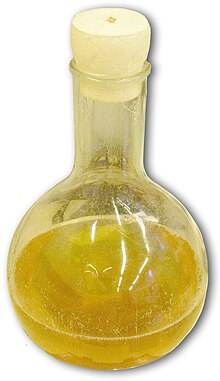Sterile plugs
Sterile stoppers and sterile plug -fit are conical sealing stoppers made of cellulose for microbiology . They are used in bacteriology , in hygiene institutes, food and crime laboratories and in educational establishments.
history
The sterile stopper was developed by Heinz Herenz in the early 1960s and registered for a patent and trademark on March 13, 1965 .
properties
Sterile stoppers are suitable for the sterile closure of bacterial cultures in test tubes, Erlenmeyer and culture flasks. They are autoclavable up to 200 ° C, filter bacteria, can be sterilized, are air-permeable and are designed for single use. They make it possible to dispense with the laborious and labor-intensive screwing in of cotton wool , which was the common method for sealing laboratory glass until the sterile stoppers were developed.
Manufacturing
In Germany, sterile stoppers are made from a special cellulose pulp produced especially for this product and wound around a mandrel at high speed with the aid of a product-neutral adhesive specially developed for this purpose . The individual shapes and sizes are specified using appropriate templates .
Product variants
The sterile stoppers are manufactured to fit all common inside diameters from 4 mm to 70 mm in 73 different versions as standard in normal hard, soft or extra hard. In addition, special stoppers for outside diameters of 6, 12 and 14 mm for laboratory tubes are produced, sterile stoppers as swabs for gynecological preventive examinations for the Cancer-Antigen 125 as well as customer-specific versions.
Individual evidence
- ↑ Patent DE1467937 : Sterilizable, gas-permeable stopper made of fiber material. Published on January 23, 1969 , inventor: Heinz Herenz.
- ↑ DE873511 , German Patent and Trademark Office (trademark register) STERI plug - register number.
- ↑ DE943905 , STERISTOPFEN-P-PASSFORM'– Register number of the German Patent and Trademark Office (trademark register).
